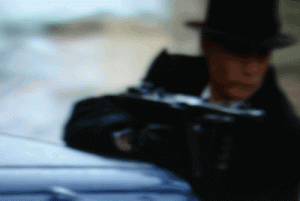 The Hurt Locker and Public Enemies.
The Hurt Locker and Public Enemies.
The Hurt Locker, 2009. Directed by Kathryn Bigelow, written by Mark Boal. Starring Jeremy Renner, Anthony Mackie, Brian Geraghty, Christian Camargo and, ever so briefly (and for no apparent reason), these stars: Guy Pierce, Ralph Fiennes, David Morse, and Evangeline Lily.
The Hurt Locker, a film about three members of the Explosive Ordinance Disposal (EOD) squad stationed in Iraq, opens with a very literal bang. Sergeant J. T. Sanborn (Anthony Mackie), Specialist Owen Eldridge (Brian Geraghty), and their leader, Sergeant Matt Thompson (Guy Pearce), have sent a robot to detonate an Improvised Explosive Device (IED–a road bomb) left in a pile of trash by a busy Baghdad neighborhood.
Whoops–a cart was attached to the robot with a device to blow it up out of harm’s way, but now the wheel has fallen off. So Sgt. Thompson has to don his big bomb suit and lay the device on top of the bombs himself. While guarding the perimeter, Spc. Eldridge sees an Iraqi grocer with a cell phone in his hand, the man watching the proceedings a bit too closely. Eldridge panics–should he shoot, and risk killing an innocent civilian, or not, and risk his friend and colleague’s death?
If you’ve seen the trailer you know the answer, and it isn’t pretty. The Sergeant is killed. But that’s not what isn’t pretty–it’s the sexy staging of the detonation, the slo-mo explosion, the rocks rising up as the shock waves emit from the blast. Not to mention the utter falseness of the scene. When the wheel falls off the cart (goofy in itself), why wouldn’t they bring the cart wobbling back, fix it, and do the whole thing over again, safely? Or how about the insurgent with the cell phone in his hand? Why would an Iraqi risk his life and the mission itself to stand out in the open with a cell phone detonator, when he could do it from inside one of the hundreds of rooms in the vicinity?
But that’s The Hurt Locker. It’s an exciting thrill-ride of a movie, and nothing more. Episodic, devoid of gore (there’s blood), strangely lacking the foul language that ribbons every sentence uttered by a grunt, and often times making no sense whatsoever, The Hurt Locker is action-director Kathryn Bigelow’s masterpiece, such as it is. And with its use of heavy metal music, its portrayal of the EOD as a thrill ride, its reduction of the Iraqis to dark faces at a distance (or, in one case, a friendly boy), it’s going to be a staple in Army recruitment offices for years to come. The Hurt Locker is the Top Gun of the new century.
The facts: Staff Sergeant William James (Jeremy Renner–very good) arrives on the scene after the death of Guy Pearce, to diffuse bombs. He works with Sgt. Sanborn and Spc. Eldridge, both of whom are nervous, anxious to survive their remaining thirty-eight days in combat. But Sgt. James is a very reckless fellow, a man who snaps off his radio, or takes off his protective suit while working on top of the IEDs (“Might as well die comfortable”), and dives headlong into dangerous situations with seeming disregard of the other two men in his unit.
And so, like the hidebound plot of Lethal Weapon, you’ve got this Mel Gibson-like maniac in Sgt. James whose recklessness might just kill someone who has just a few days left before retirement. Only it doesn’t. I don’t know why, but I was struck right away with the fact that none of the principals in The Hurt Locker were going to die. Oh, the psychologist who has never spent time in the field, Colonel John Cambridge (Christian Camargo, simply awful and sounding like Dave Chappel’s imitation of a white guy), and who is desperately trying to reach through to cynical Spc. Eldridge, will most certainly come to a clumsy end, but everyone else? Don’t count on it.
For all the hype about The Hurt Locker realism, the movie is almost totally a falsehood. Each and every bomb scene is manufactured to raise the tension in ways that are similar to, say, the scared girl opening every closet in a Halloween movie, when simply running out the door and to the cops would be a better bet.
Consider the scene where Sgt. James is walking down a street to defuse a cluster of about ten bombs a few blocks away. The area is guarded by a good two dozen soldiers. Suddenly, and without warning, a taxicab races toward the scene! Well, this guy guns his engine, drives swiftly and erratically past a good dozen soldiers with weapons drawn, screeching to a halt in front of Sgt. James. James orders the man to retreat, even going so far as to shooting out the taxi driver’s window. After a good long time, as we wonder what this Iraqi will do (not really) the driver retreats, and Sgt. James breathes deeply in relief, holsters his weapon, and goes about the tense business of defusing the bombs.
Why would this Iraqi drive like that? To careen headlong into a clot of U. S. soldiers with guns drawn? By now Iraqis stay away from these scenes, certainly don’t gun their engines, unless, of course, they’re suicide bombers, in which case, you wonder why this man didn’t detonate his car. And here’s a note for director Bigelow: Spc. Eldridge might not fire on the cell-phone bomber early in the movie, and here one of the dozen soldiers might not fire on the taxi driver… but all of them? It’s their duty to take this guy out if he’s going to threaten the bomb squad and themselves. Someone would have taken out that taxi driver, and have had good reason to do so.
There’s about two dozen times in this movie where scenes don’t make sense, from the Corporal’s utter idiocy at the dangers around him, to a Sgt. suddenly having the talent of the Army’s top snipers (who, it might interest Bigelow to know, do not simply have a good eye and patience–it’s a science like being in the bomb unit), to Australians wearing Iraqi outfits but not speaking English at first so as to quickly identify themselves to trigger-happy Americans.
Bigelow does her level best to try to bring some insight into these characters and their scenes. Spc. Eldridge is death obsessed, but we know this only because he says so, though never convincingly. We never see any of the madness rampant in any war. Sgt. James becomes pals with a young kid who calls himself Beckham, and then freaks out when he thinks the child has died. He also goes berserk over a large-scale bombing, running with his pals Sanborn and Eldridge down an Iraq street (choosing that one because “bad guys hide in the dark”) in order to serve up some justice. Has he gone crazy from defusing over 800 bombs? Or is this scene of empty revenge yet another falsehood, a manufactured moment meant to pump up our adrenaline?
Personally, I feel queasy about war pictures that can be used to help send young kids over to fight, feeding them full of macho images and avoiding the true chaos, blood, red-tape, and utter boredom and fatigue that makes up war. The Hurt Locker very good as a pure action film, as utterly devoid of reality as the aforementioned Top Gun, which is why it’ll probably be as popular as all get out. A friend said that the director’s not responsible for what people–in this case Army recruiters–do with their film, and I suppose he’s right. But The Hurt Locker, with its driving rock score, its lack of gore (there’s blood, but the explosions are surprisingly easy to take), and its edgy, cool-ass hero, is most certainly going to draw some self-conscious kid into the maw of some future conflict. If Kathryn Bigelow’s OK with that, all I can say is, more power to her.
Public Enemies, 2009. Directed by Michael Mann, written by Mann and Ronan Bennett. Starring Johnny Depp, Christian Bale, Marion Cotillard, Billy Crudup, and a large cast of people who you never really get to know, and Giovanni Ribisi, who should have played Dillinger.
Public Enemies has a great first hour. The story of John Dillinger (Johnny Depp) helps bring about the escape of his gang and his mentor Walter (James Russo), who is killed. The men make their way to an old farmhouse where they get some needed supplies, and flee. A woman chases after Dillinger, and begs him to take her with him. It is an amazing scene, with Depp and the woman chasing him, the two bodies against the setting sun, and when Dillinger rejects her, the camera pans back to frame her against her old, weather beaten house. We have the distinct sense that this is the world of boredom and hardship Dillinger left behind, and the reason he will be celebrated.
Then we go to Agent Melvin Purvis of the FBI (played by Christian Bale, who has mercifully given up that gravel-y mumble for normal speech). Purvis is out to get Dillinger, who is Public Enemy #1, and it using the best, most cutting edge technology to capture their man. Purvis is dedicated, honest, and rides the political waves created by his boss, J. Edgar Hoover (a very good Billy Crudup). Great. It all looks good.
Dillinger’s rapid-fire courtship of coat-check girl Billie Frechette (Marion Cotillard, very good) is fun and a sexy thrill. They have a very special love–unfortunately, we come to know that because the screenwriter tells us this and we don’t quite know what made Dillinger go crazy for her. The girl, OK, she wants the thrill ride. But Dillinger? There’s plenty of fish in the sea, and we need to see why this particular mackerel interests him so profoundly.
At first I compared Public Enemies to David Fincher’s outstanding Zodiac, thinking that the former is the opposite of the latter. Fincher’s movie is about the deep and existential frustration inherent in police work, and especially in the Zodiac case, with old technology and jurisdictional problems ruining solid police work. Here, we see new technology bringing a man down, a man who must frustrate the cops for all his celebrity. We see the police recording telephone conversations on LP records, spreading out with the assistance of different districts, using psychology to guess the location of Dillinger and his men.
But director Michael Mann wasn’t happy with that, and about an hour in Public Enemies careens off track. Dozens of faces join Dillinger’s gang, as do an equal number in Purvis’ crew. They come and go, die off, become brutes and saviors, and we don’t know who the hell they are. Themes developed in the beginning are dropped willy-nilly.
Worse in my mind was the casting of Giovanni Ribisi in a very small role as a fellow robber. Ribisi has made a ton of horrible choices in his career, but he’s a brilliant actor, capable of great kindness and utter cruelty. John Dillinger, in real life, was not an incredibly handsome man, who used his notoriety to win girls and luxury. I don’t think there’s any question that this is what brought him and Billie together, and that might be a reason why Dillinger clung so closely to her. Depp’s Dillinger is a cipher, an incredibly handsome man, who would be pawed over no matter if he was a criminal or a bank teller. We never see him truly hurt, don’t understand his motivations, all we see is one cool cat, and nothing more. And we need something more.
Ultimately, Public Enemies is also a falsehood, not a story of crime or of the Depression, but a slick music video (and the music isn’t even consistent, flitting between modern rock that sounds like a Lynyrd Skynrd comeback, to Billie Holiday tunes) meant only to show off manic camera work, beautiful actors, and a budget big enough to support extravagant costume and set design. It says nothing about crime, the Depression, or even love and loyalty.
If you want a movie that sums up crime in this era, and other meaningful themes, check out either Arthur Penn’s Bonnie and Clyde or, better yet, Nicholas Ray’s They Live By Night based on the great Edward Anderson novel Thieves Like Us. Those are honest works, entertaining as all hell, with real people, and not just men in suits.

